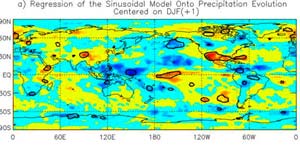Earth Sciences
Earth Sciences (also referred to as Geosciences), which deals with basic issues surrounding our planet, plays a vital role in the area of energy and raw materials supply.
Earth Sciences comprises subjects such as geology, geography, geological informatics, paleontology, mineralogy, petrography, crystallography, geophysics, geodesy, glaciology, cartography, photogrammetry, meteorology and seismology, early-warning systems, earthquake research and polar research.

Scientists to Probe Giant Storm Clusters Across Mid-Western States
From the air and the ground, scientists this spring and summer will examine some of the world’s largest thunderstorm complexes, behemoths that can spread hurricane-force wind and torrential rain for hundreds of miles across the U.S. Midwest. The study, scheduled from May 20 to July 6, should provide the clearest picture to date of how such storms wreak havoc and how forecasters can better predict trails of storm damage. The Bow Echo and MCV Experiment (BAMEX) is organized by scientists

Nasa Discovers aSoggy Secret of El Niño
NASA-funded researchers have discovered El Niño’s soggy secret. When scientists identified rain patterns in the Pacific Ocean, they discovered the secret of how El Niño moves rainfall around the globe during the life of these periodic climate events when waters warm in the eastern Pacific Ocean.
The results may help scientists improve rainfall forecasts around the globe during the life of an El Niño, and may also offer new insights into how an El Niño develops.
The findings were hi

Growing world urban populations threatened by massive earthquakes
A new study by a University of Colorado at Boulder geological sciences professor suggests one earthquake causing up to 1 million fatalities on Earth each century could occur unless more earthquake-resistant construction materials are implemented.
Professor Roger Bilham’s conclusions are based on a study of the world’s urban population growth in the 21st century, including the number of rapidly expanding “supercities” and their locations close to major fault lines that have caused past tembl

Livermore researchers discover uncertainties in satellite data hamper detection of global warming
Using a new analysis of satellite temperature measurements, scientists from the Lawrence Livermore National Laboratory have determined that uncertainties in satellite data are a significant factor in studies attempting to detect human effects on climate.
Since 1979, Microwave Sounding Units (MSUs) have been flown on 12 different polar-orbiting weather satellites operated by the U.S. National Oceanic and Atmospheric Administration. MSU instruments measure the microwave emissions of oxygen mo

Syracuse University geologists raise questions about controversial theory of species survival
A recent study by a team of Syracuse University geologists has punched holes in a relatively new theory of species evolution called coordinated stasis; the theories involved are based on findings from fossil-bearing rocks that underlie Central New York. The SU study was published in “Geology,” the premier journal of the Geological Society of America.
First proposed in 1995 by Carl Brett of the University of Cincinnati and Gordon Baird of the State University of New York at Fredonia, coordinated

NASA satellite measures Earth’s carbon metabolism
In honor of the Earth Day celebration, NASA scientists unveiled the first consistent and continuous global measurements of Earth’s “metabolism.” Data from the Terra and Aqua satellites are helping scientists frequently update maps of the rate at which plant life on Earth is absorbing carbon out of the atmosphere.
Combining space-based measurements of a range of plant properties collected by the Moderate Resolution Imaging Spectroradiometer (MODIS) with a suite of other satellite and su